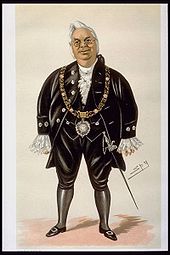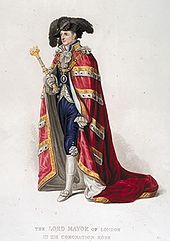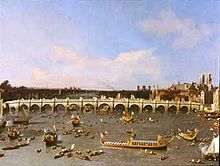- Lord Mayor of London
-
This article is about the post of Lord Mayor of the City of London. For the elected mayor of Greater London, see Mayor of London.
Lord Mayor of London 
Residence Mansion House Appointer Liverymen of the City of London Livery Companies Term length 1 year Inaugural holder Henry Fitz-Ailwin de Londonestone Formation 1189 Website www.cityoflondon.gov.uk The Right Honourable Lord Mayor of London is the legal title for the Mayor of (and head of) the City of London Corporation. The Lord Mayor of London is to be distinguished from the Mayor of London; the former is an officer only of the City of London, while the Mayor of London is the Mayor of Greater London and as such governs a much larger area. Within the City of London, the Lord Mayor has precedence over other individuals and has various special powers, rights and privileges.
In 2006 the Corporation of London changed its name to the City of London Corporation. At the same time the title Lord Mayor of the City of London came into use, partly to avoid confusion with the Mayor of London. However, the legal and commonly-used title remains the Lord Mayor of London.
The Lord Mayor is elected each year at Michaelmas 'Common Hall', and takes office on the Friday before the second Saturday in November, at 'The Silent Ceremony'. On the day after taking office, the Lord Mayor's Show is held; the Lord Mayor, preceded by a procession, travels to the Royal Courts of Justice on the Strand, Westminster to swear allegiance to the Sovereign in the presence of the judges of the High Court.
The Lord Mayor's main role is, as it has been for centuries, to represent, support and promote the businesses and the people of the City of London. Today, these businesses are mainly in the financial sector and the Lord Mayor is seen as the champion of the entire UK-based financial sector regardless of ownership and location within the country. As head of the Corporation of the City of London, the Lord Mayor is the key spokesman for the local authority and also has important ceremonial and social responsibilities. He is apolitical, which gives added credibility at home and abroad when representing the financial sector. He gives over 800 speeches in the year and spends over 100 days abroad in some 22 countries. The Lord Mayor is also the Chancellor of the City University of London and is assisted in the daily operation of the city by the leading personnel for the City of London[2] whose titles are the Town Clerk and Chief Executive, Chamberlain and Remembrancer.
The Lord Mayor for 2011–12[update] is Alderman David Wootton.[3]
Contents
Titles and honours
 Portrait of Lord Mayor of London William M'Arthur, by Leslie Ward, 1881
Portrait of Lord Mayor of London William M'Arthur, by Leslie Ward, 1881
Of the 66 cities in the United Kingdom, the City of London is among the 30 that have Lord Mayors (or, in Scotland, Lords Provost). The Lord Mayor is entitled to the style The Right Honourable; the same privilege extends only to the Lord Mayors of York, Cardiff and Belfast, and to the Lords Provost of Edinburgh and Glasgow. The style, however, is used when referring to the office as opposed to the holder thereof; thus, "The Rt Hon The Lord Mayor of the City of London" would be correct, while "The Rt Hon John Smith" would be incorrect. The latter style applies only to Privy Counsellors.
A woman who holds the office is also known as a Lord Mayor. A male Lord Mayor's wife is known as a Lady Mayoress; no equivalent privilege exists for a female Lord Mayor's husband. A female Lord Mayor or unmarried male Lord Mayor may appoint a female consort, usually a fellow councillor, to the role of Lady Mayoress. In speech, a Lord Mayor is referred to as "My Lord Mayor", and a Lady Mayoress as "My Lady Mayoress".
It was once customary for Lord Mayors to be created knights upon taking office and baronets upon retirement, unless they held those titles already. The custom was applied inconsistently from the 16th until the 19th centuries; creations became more regular from 1889 onwards. From 1964 onwards, the regular creation of hereditary dignities such as baronetcies ceased, but Lord Mayors continued to be granted knighthoods (usually of the rank of Knight Grand Cross of the Order of the British Empire) until 1993. Since 1993, Lord Mayors have not received any automatic honours upon appointment; instead, they have been created Knights Bachelor upon retirement, although Gordon Brown's government broke with tradition by awarding Ian Luder the CBE after his term of office in 2009, and the following year Nick Anstee declined the offer of any national honour. Furthermore, when foreign Heads of State visit the United Kingdom, they sometimes confer honours on the Lord Mayor. For example, in 2001, Sir David Howard was created a Grand Cordon, First Class, of the Order of Independence of Jordan following the state visit of King Abdullah II. Additionally in recent years Lord Mayors have been appointed Knights of St John (KStJ), of which order HM The Queen is Sovereign Head.
History
The office was instituted in 1189 with the first holder of the office being Henry Fitz-Ailwin de Londonestone. The Mayor of the City of London has been elected by the City, rather than appointed by the Sovereign, since a Royal Charter providing for the same was issued by King John in 1215. The title "Lord Mayor" came to be used after 1354, when it was granted to Thomas Legge (then serving his second of two terms) by King Edward III.
Lord Mayors are elected for one-year terms; by custom, they do not now serve more than one consecutive term. Numerous individuals have served multiple terms in office, including:
As Mayor:- 24 terms: Henry Fitz-Ailwin de Londonestone (1189-1212)
- 9 terms: Ralph de Sandwich (1285-1289,1289-1292)
- 8 terms: Gregory de Rokesley (1274-1280,1284)
- 7 terms: Andrew Buckerel (1231-1237); John le Breton (1289, 1293-1298); John le Blund (1301-1307)
- 6 terms: Richard Renger (1222-1226,1238); Hamo de Chigwell (1319,1321,1322,1324,1325,1327)
- 5 terms: Serlo le Mercer (1214, 1218-1221)
As Lord Mayor:
- Nicholas Brembre (1377,1383-1385 - 4 terms)
- Richard ('Dick') Whittington (1397, 1398, 1406 and 1419 - 4 terms)
The last individual to serve multiple terms was Robert Fowler (elected in 1883 and in 1885).
Dame Mary Donaldson, elected in 1983, is the only woman to have held the office thus far. Almost 700 people have served as Lord Mayor.
Some Lord Mayors in the Middle Ages, such as Sir Edward Dalyngrigge (1392), did not reside in London. Since 1435, the Lord Mayor has been chosen from amongst the Aldermen of the City of London.
Election
The Lord Mayor is elected by Common Hall, all Liverymen of the City's Livery Companies. Common Hall is summoned by the sitting Lord Mayor; it meets at Guildhall on Michaelmas Day (29 September) or on the closest weekday. Voting is by show of hands; if, however, any liveryman so demands, balloting is held a fortnight later.
Since 1385, prior service as Sheriff has been mandatory for election to the Lord Mayoralty. Two Sheriffs are selected annually by Common Hall, which meets on Midsummer's Day for the purpose. By an ordinance of 1435, the Lord Mayor must be chosen from amongst the Aldermen of the City of London. The people of each of the city's 25 wards select one alderman, who formerly held office for life or until resignation. Now each alderman must submit himself for re-election at least once in every six years. An individual elected Lord Mayor need not relinquish membership of the Court of Aldermen.
The Lord Mayor is then sworn in November, on the day before the Lord Mayor's Show (see below). The ceremony is known as the "Silent Ceremony" because, aside from a short declaration by the incoming Lord Mayor, no speeches are made. At Guildhall, the outgoing Lord Mayor transfers the mayoral insignia—the Seal, the Purse, the Sword and the Mace—to the incoming Lord Mayor.
Lord Mayor's Show
Main article: Lord Mayor's ShowOn the day after being sworn in, the Lord Mayor participates in a procession from the City of London to the Royal Courts of Justice in the City of Westminster, where the Lord Mayor swears his allegiance to the Crown. This procession is known as the "Lord Mayor's Show" and is one of the longest established and best known annual events in London. The Lord Mayor travels in a State Coach that was built in 1757 at a cost of £1,065.0s.3d. (£120,200 as of 2011).[4] In its modern form, it is a fairly light-hearted combination of traditional British pageantry and elements of carnival. Since 1959 it has been held on the second Saturday in November. Participants include the Livery Companies, bands and members of the military, charities and schools. In the evening, a fireworks display is held.
Role
The Lord Mayor is a member of the City of London's governing body, the City of London Corporation (incorporated as The Mayor and Commonalty and Citizens of the City of London). The Corporation comprises the Court of Aldermen and the Court of Common Council; the former includes only the Aldermen, while the latter includes both Aldermen and Common Councilmen. The Lord Mayor is a member of and presides over both bodies.
As noted earlier, the main role of the Lord Mayor is to represent, support and promote the financial, maritime and other business services industry in the UK. He undertakes this as head of the City of London Corporation and, during his year, hosts visiting foreign Ministers, businessmen and dignitaries; furthermore, he conducts several foreign visits of his own in order to promote the British financial sector.
Banquets hosted by the Lord Mayor often serve as opportunities for senior Government figures to make major speeches. At the Lord Mayor's Banquet (held on the Monday after the Lord Mayor's Show), the Prime Minister delivers the keynote address. At the Banker's Dinner in June, the Chancellor of the Exchequer delivers a speech known as the Mansion House Speech, which takes its name from the Lord Mayor's residence. At the Easter Banquet, which is also hosted at Mansion House, a speech is delivered by the Secretary of State for Foreign and Commonwealth Affairs.
The Lord Mayor performs numerous other functions. He serves as the Chief Magistrate of the City of London, Admiral of the Port of London, Chancellor of City University, President of Gresham College, President of City of London Reserve Forces and Cadets Association, and Trustee of St Paul's Cathedral. The Lord Mayor is also the head of the Commission of Lieutenancy, which represents the Sovereign in the City of London (other counties usually have Lord Lieutenants, as opposed to Commissions), and annually attends the Treloar Trust (named after Sir William Treloar, Lord Mayor in 1906), in Hampshire. The Treloar Trust runs two educational sites for disabled children, a school and college.[5]
Rights and privileges
The residence of the Lord Mayor is known as Mansion House. The creation of the residence was considered after the Great Fire of London (1666), but construction did not commence until 1739. It was first occupied by a Lord Mayor in 1752, when Sir Crispin Gascoigne took up his residence in it.
It is sometimes asserted that the Lord Mayor may exclude the Sovereign from the City of London. The legend is based on the misinterpretation of the ceremony observed each time the Sovereign enters the City. At Temple Bar the Lord Mayor presents the City's pearl-encrusted Sword of State to the Sovereign as a symbol of the latter's overlordship. The Sovereign does not, as is often purported, wait for the Lord Mayor's permission to enter the City.
The importance of the office is reflected by the composition of the Accession Council, a body which proclaims the accession of new Sovereigns. The Council includes the Lord Mayor and Aldermen of London, as well as the Lords Spiritual, Lords Temporal and Privy Counsellors. At the coronation banquet which followed, the Lord Mayor of the City of London had the right to assist the royal butler. The same privilege is held by the Lord Mayor of Oxford; the Mayor of Winchester may assist the royal cook. Such privileges have not been exercised since 1821, when the last coronation banquet (commemorating the coronation of George IV) was held.
Since 1545 the lord mayor of London has worn a royal livery collar of Esses. This collar, however, has its origin in no royal favour, Sir John Alen, thrice a lord mayor, having bequeathed it to the then lord mayor and his successors "to use and occupie yerely at and uppon principall and festivall dayes." It was enlarged in 1567, and in its present shape has 28 Esses (the Lancastrian ‘S’), the Tudor rose, the tasselled knots of the Garter and also the portcullis.[6]
List of Lord Mayors of London
Main article: List of Lord Mayors of LondonSee also
- City status in the United Kingdom
- List of Lord Mayors of London
- Lord Mayor of Dublin
- Mayor of London
- Mayors in the United Kingdom
- Town Clerk of London
References
- City of London Corporation home page
- Jenkins, S. (2004). "Royal Coronations and Oxford Mayors."
- "London (England)." (1911). Encyclopædia Britannica, 11th ed. London: Cambridge University Press.
- "Lord Mayor's Show." (2002).
- "The Lord Mayor's Show Saturday 13th November 2004." (2004).
- "Temple Bar." (1911). Encyclopædia Britannica, 11th ed. London: Cambridge University Press.
- Stuttard, John (2008). Whittington to World Financial Centre - The City of London and its Lord Mayor. Phillimore & Co. ISBN 9781860775864.
Notes
- ^ Lord Mayor David Wootton
- ^ Leading personnel page at: http://www.cityoflondon.gov.uk/Corporation/LGNL_Services/Council_and_democracy/Council_departments/Leading+personnel.htm - See also: Town Clerk of London.
- ^ "The Lord Mayor of the City of London". City of London Corporation. http://www.cityoflondon.gov.uk/Corporation/LGNL_Services/Council_and_democracy/Councillors_democracy_and_elections/The_Lord_Mayor/. Retrieved 2011-11-11.
- ^ UK CPI inflation numbers based on data available from Lawrence H. Officer (2010) "What Were the UK Earnings and Prices Then?" MeasuringWorth.
- ^ A more detailed account of the role of the Lord Mayor can be found in former Lord Mayor Sir John Stuttard's Whittington to World Financial Centre - The City of London and its Lord Mayor (2008 by Phillimore & Co) ISBN 978-1-86077-586-4.
- ^ "The Lord Mayor of London's treasures go on show as the Mansion House opens its doors". The Daily Telegraph. http://www.telegraph.co.uk/news/picturegalleries/uknews/3511978/The-Lord-Mayor-of-Londons-treasures-go-on-show-as-the-Mansion-House-opens-its-doors.html. Retrieved 11 May 2010.
External links
Governance of Greater London Regional London boroughs - Barking and Dagenham
- Barnet
- Bexley
- Brent
- Bromley
- Camden
- Croydon
- Ealing
- Enfield
- Greenwich
- Hackney
- Hammersmith and Fulham
- Haringey
- Harrow
- Havering
- Hillingdon
- Hounslow
- Islington
- Kensington and Chelsea
- Kingston upon Thames
- Lambeth
- Lewisham
- Merton
- Newham
- Redbridge
- Richmond upon Thames
- Southwark
- Sutton
- Tower Hamlets
- Waltham Forest
- Wandsworth
- Westminster
Ceremonial - Lord Mayor of the City of London
- Lord Lieutenant of Greater London
Historical - Metropolitan Board of Works (MBW) 1855–1889
- London County Council (LCC) 1889–1965
- Greater London Council (GLC) 1965–1986
- Leaders
City University London Subdivisions and
publicationsCass Business School · City Law School (Inns of Court School of Law) · School of Arts (Journalism Department) · School of Community and Health Sciences (St Bartholomew School of Nursing & Midwifery) · School of Engineering and Mathematical Sciences · School of Informatics (Centre for Software Reliability) · School of Social Sciences
University PeopleAcademics · Alumni · Chancellor: Lord Mayor of the City of London (ex officio) · Vice Chancellor: Professor Paul CurranOtherAffiliates Information Centre about Asylum and Refugees · London Centre for Arts and Cultural Exchange · Partnerships and collaborations · Spin-out companies · Universities UK
Categories:- Local government in London
- Lord Mayors of London
- City of London
- Politics of the United Kingdom
- People associated with City University London
- People associated with the Royal National College for the Blind
- Ceremonial officers in the United Kingdom
Wikimedia Foundation. 2010.





